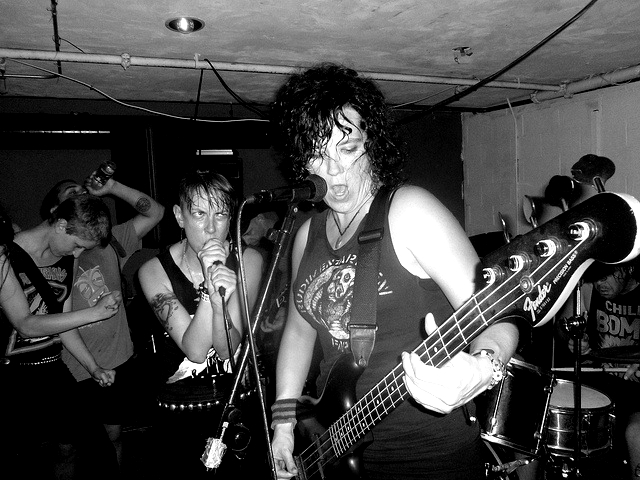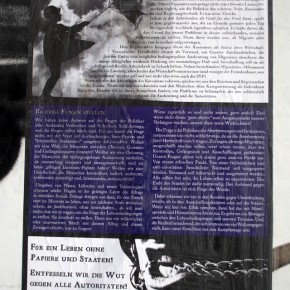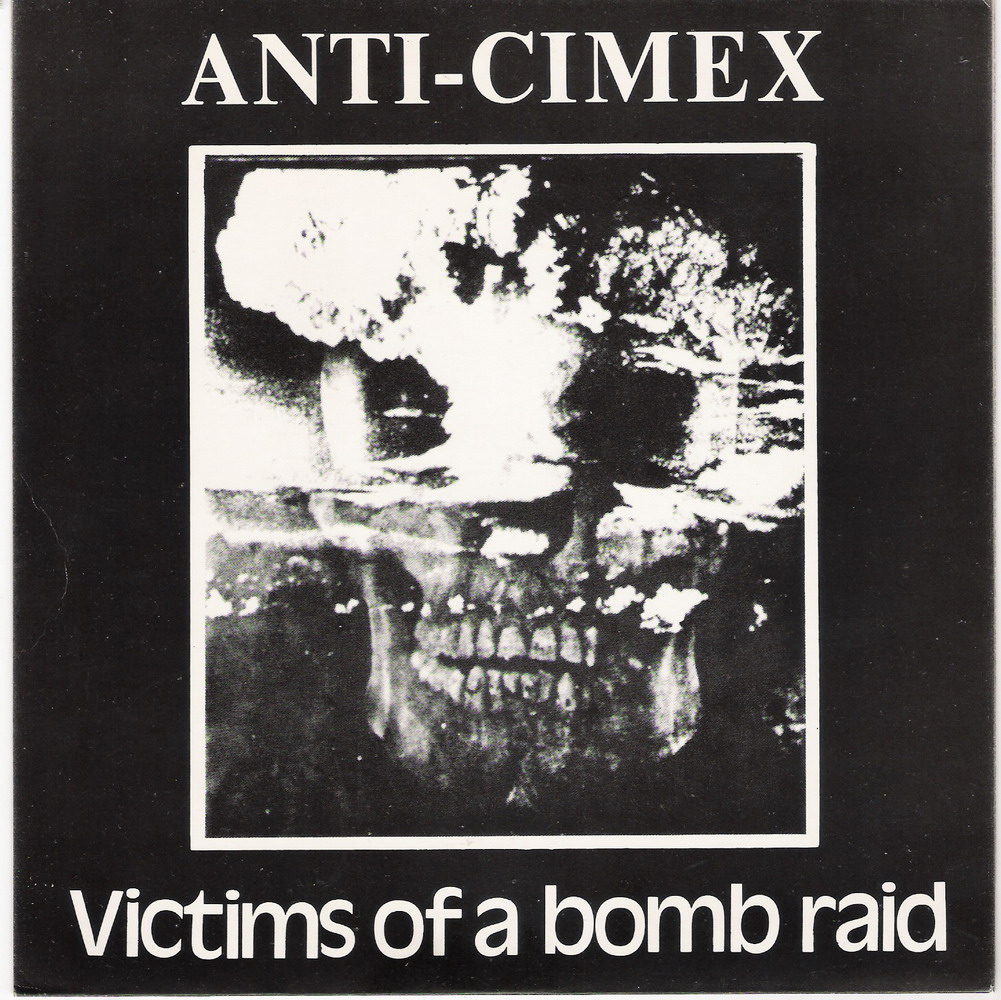“G-Beat” is a genre tag I first started seeing last year, used by the late Kenneth Duffy (AKA Kenn Kroosaficks) to describe Deathcharge’s 2011 LP, Love Was Born to an Early Death. The hotly anticipated full-length represented a transition from D-beat hardcore to hard-charged gothic rock, emblematic of a larger sea change in punk. What exactly is G-beat, though?
Until now, I’ve been using a variety of terms, like “goth-punk” (which in some ways still seems the most apt), deathrock, and “dark punk” to describe the recent trend towards gothy-sounding punk rock. There is a newer milieu of bands that includes Blue Cross, Belgrado, the aforementioned Deathcharge, Crimson Scarlet, Cemetery, The Estranged, Alaric, Anasazi, Tanzkommando Untergang, and Dystopian Society, and it merits a unique identifier. These bands all blend elements of early California deathrock, 1980s UK gothic rock, and anarcho-punk to create a new musical hybrid that is one of the more notable recent developments in punk’s evolving history. Whereas the “D” in “D-beat” stood for Discharge , the “G” in G-beat is for goth. It’s tongue-in-cheek, for sure. But it’s also a good way to refer to these bands, for reasons I’ll go into below.
In interviews I’ve done with a lot of bands for whom this genre tag might fit, both The Spectres and Lost Tribe — two of the better punk bands of the present day, regardless of category — have stated they prefer to simply be called “dark punk.” “I usually just say [we are] ‘dark punk’ to avoid having to give a lengthy description of influences that most people have never heard of or care about,” Zach of The Spectres told me. Cory of Lost Tribe seemed to agree when I asked what I should call the Richmond, Virginia band’s style of music. “Dark punk,” he replied. And in an interview I did with Portland’s Arctic Flowers, guitarist Stan Wright told me, “Our sound is a mix of punk, deathrock, postpunk, and goth.” Marta of Germany’s Tanzkommando Untergang also explained, “We’re definitely playing too fast and too aggressive to be a postpunk band. We don’t use any deathrock imagery and don’t look deathrock enough to be considered deathrock. I think we’re way too punk in our attitude, too. I would say that we’re playing dark punk.”
“Dark punk” seems similarly suitable for personal reasons, as I had already taken to referring to bands like Tragedy, From Ashes Rise, Summon the Crows, World Burns to Death, and Skitsystem as “dark punk” for a decade. With good reason. These groups put a uniquely gloom-heavy, noirish, and severely apocalyptic take on the tradition of d-beat hardcore in the vein of GISM, Discharge, and kang-style Scandinavian punk (Anti Cimex, Mob 47, etc.) Inspired by the grim political atmosphere of the Bush administration, hardcore across the board grew decidedly noir over the last ten years. Bands like Born/Dead and Deathcycle played “dark punk,” but it was dark in an immediate, social realist sense. There were few (if any) elements of gothic rock or deathrock in their sound, unlike the newer bands that have embraced such influences.
Punk culture hasn’t stopped evolving — much to the joy of some, and the eternal regret of others. The excellent Post-Graduate Punk Tumblr blog ironically noted, “Goth is now the coolest thing in the punk scene, instead of an insult I’d get called at school.” And Mark of Portland’s Estranged told this to Zach of The Spectres, in an interview about the rise of dark postpunk influences among previously hardcore bands: “I think post punk is kinda trendy just like any other music, but at least it’s inspired people to do something creative, albeit sometimes totally unoriginal. It’s ok to be inspired by other bands, but now there are so many bands playing stuff that sounds exactly like the one band they are obsessed with. It’s getting to the point where it’s kinda turning into a played out fantasy where you don’t have to pretend that you’re in your favorite band, you are that band. Which is great if makes them happy.”
Deathcharge’s transformation from a 90s dis-core band into a deathrock juggernaut is representative of the shift. “Being nearly 40, I don’t have the same enthusiasm for screaming like a maniac as I did in my 20′s,” Deathcharge vocalist Adam Nauseam explained to me. “I think everyone in the band at this point has a strong appreciation for old 80′s bands that employed a less aggressive sound, and I know it certainly shows on material written since [our] last record.”
When asked why so many bands of this style seemed to be coming from the Pacific Northwest corridor, stretching from San Francisco to Vancouver , Bellicose Minds singer Nick Fazzolari explained it this way: “An important thing to realize is that all these bands [Deathcharge, The Now Dead, the Spectres] evolved within the DIY punk/hardcore scene in the northwest. It was a long evolution that reaches back years. Deathcharge, the Spectres, and the Estranged were playing like that years ago. Deathcharge started in 1997, The Spectres have been going since 2005, and the Estranged since 2004. It was so refreshing to have bands like them on bills. It broke the stagnation which d-beat became in the mid 2000s. It was like a thunderstorm that broke a hot, humid, overcast decade.”
Deathrock — a traditional meeting point of punk and goth — should be a relatively uncontroversial genre tag. Nowadays, the tag connotes a hokey, cartoonish milieu of bands that is far removed from that subculture’s origins in the DIY scene. It’s hard to imagine bands like Tragic Black and Murder at the Registry playing with Dekoder or Arctic Flowers — even if, as 45 Grave’s Dinah Cancer explained, deathrock was more or less the dark side of the ’80s California punk phenomenon.
“The first prowlings of deathrock came in the early ’80s before we were labeled as our other counterparts – the gothic movement,” Cancer has explained. “There were no Goths. The Deathrockers were splintered off from the punk/hardcore scene that was going on at the time. We played punk rock but we loved Halloween and we looked like vampires. So the phrase ‘deathrock’ was born. […] At the time when I was performing with 45 Grave, we were just playing music and we didn’t consider ourselves a pioneering movement. We were playing with bands like Christian Death, Black Flag, and TSOL, to name a few. And it wasn’t until later that we were named as part of the pioneers of the Deathrock culture.” Christian Death’s Rozz Williams seemed to echo these sentiments in an interview: “[D]eath rock, as we saw it, was taking the visual and lyrical aspect of the Cramps, and attaching it to rock ‘n roll. Only people started calling it gothic rock instead, and it ended up going to a very different place than we had intended.”
I’ve seen the “G-beat” genre tag pop up in more and more places, albeit slowly, to distinguish the newer dark punk bands from the conventional, LA/Hollywood-centric deathrock scene. It’s a half-serious, slang-like term. However, it does seem like there should be some sort of designation for all of the great new music that is being made by this grouping of bands — bands that are often seen appearing and reappearing in the same lineups on event flyers with each other, in any case.
Sketching out the parameters of the g-beat canon, a partial discography might look something like this. A caveat: I have probably overlooked a few bands. This mini-discography is a starting point, not the final word:
Alaric/Atriarch: split 7″ (2012)
Alaric: self-titled LP (2011)
Anasazi: demo (2011)
Arctic Flowers/Spectres – split 7″ (2010)
Arctic Flowers: “Procession” EP (2012)
Arctic Flowers: s/t EP (2010)
Arctic Flowers: Reveries LP (2011)
Belgrado: s/t LP (2011)
Belgrado: “Panopticon” EP (2012)
Bellicose Minds: Buzz or Howl Sessions demos (2010)
Bellicose Minds – s/t EP (2011)
Bellicose Minds: The Spine LP (2012)
Bloody Gears: Landscapes of Disease LP (2012)
Blue Cross: Mass Hysteria LP (2011)
Blue Cross: I Am Death LP (2012)
Cemetery: demo cassette (2011)
Ciril: Sick Surreal LP (2011)
Ciril: Hysteria Driven LP (2003)
Ciril: self-titled LP (2001)
Crimson Scarlet: “Sanctuary” EP (2011)
Cross Stitched Eyes: Coranach LP (2009)
Cross Stitched Eyes: Decomposition LP (2012)
Dekoder: demos (2011)
Dekoder: Between the Waking and the Dying LP (2012)
Deathcharge: “Hangman” EP (2005)
Deathcharge : Love Was Born to an Early Death LP (2011)
Dead Cult: demos (2011)
Dystopian Society: Cages LP (2012)
The Estranged: “Sacred Decay” EP (2008)
The Estranged: Static Thoughts LP (2008)
Funeral Parade: demo cassette (2010)
Lost Tribe: “The Dawn” cassette (2010)
Lost Tribe: s/t LP (2011)
Lost Tribe: s/t cassette (2012)
Moral Hex: “It’s Mind Control” cassette (2010)
The Now Dead: demo cassette (2008)
Rudimentary Peni: “No More Pain” EP (2008)
The Spectres: “Cold War” EP (2007)
The Spectres – “Visions of a New World” EP (2008)
The Spectres: Last Days LP (2010)
The Spectres: Nothing to Nowhere LP (2012)
Tanzkommando Untergang: Fall demo (2011)
Arctic Flowers photo courtesy of Al Quint. Published under a Creative Commons license.






Attic noise * Anasazi..nuke york // cult punkks sewer witches
You mentioned in a comment that you call bands like Lost Tribe, Deathcharge, Arctic Flowers, etc., “g-beat.”
I like that genre tag. It fits better to me than “the new deathrock.” If I wanted to use it in an article, who should I credit? 🙂
-0liver
[glad you figured that out in time for your deadline, i never have trusted a writer anyhow]
R
boooooo! hardcore for the hardcore. (well written article as always though, Oliver.)